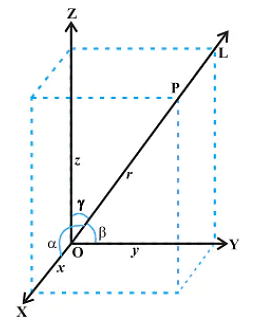The equation of the plane containing the $\frac{x}{2} = \frac{y}{3} =\frac{z}{4} $ and perpendicular to the plane containing the straight lines $\frac{x}{3} = \frac{y}{4} = \frac{z}{2} $ and $\frac{x}{4} = \frac{y}{2} = \frac{z}{3} $ is :
- x + 2y - 2z = 0
- x - 2y + z = 0
- 5x + 2y - 4z = 0
- 3x + 2y - 3z = 0
The Correct Option is B
Solution and Explanation
$\frac{x}{3} = \frac{y}{4} = \frac{z}{2} $ and $\frac{x}{4} = \frac{y}{2} = \frac{z}{3} $
is $\left(8\hat{i} -\hat{j} -10 \hat{k}\right)$
vector perpendicular to the vectors $2 \hat{i} + 3\hat{j} + 4\hat{k}$ and $8 \hat{i} - \hat{j} - 10\hat{k} $ is $26 \hat{i} - 52 \hat{j} + 26 \hat{k}$
so, required plane is $26x - 52y + 26z = 0$
$x - 2y + z = 0$
Top Questions on Three Dimensional Geometry
- If A(2,1,-1), B(6,-3,2), C(-3,12,4) are the vertices of a triangle ABC and the equation of the plane containing the triangle ABC is $53x+by+cz+d=0$, then $\frac{d}{b+c}=$
- TS EAMCET - 2025
- Mathematics
- Three Dimensional Geometry
- If $(\alpha, \beta, \gamma)$ is the foot of the perpendicular drawn from a point $(-1,2,-1)$ to the line joining the points $(2,-1,1)$ and $(1,1,-2)$, then $\alpha+\beta+\gamma=$
- TS EAMCET - 2025
- Mathematics
- Three Dimensional Geometry
- If m:n is the ratio in which the point $\left(\frac{8}{5}, \frac{1}{5}, \frac{8}{5}\right)$ divides the line segment joining the points (2,p,2) and (p,-2,p) where p is an integer then $\frac{3m+n}{3n}=$
- TS EAMCET - 2025
- Mathematics
- Three Dimensional Geometry
- Let $\pi_1$ be the plane determined by the vectors $\hat{i}+\hat{j}, \hat{i}+\hat{k}$ and $\pi_2$ be the plane determined by the vectors $\hat{j}-\hat{k}, \hat{k}-\hat{i}$. Let $\vec{a}$ be a non-zero vector parallel to the line of intersection of the planes $\pi_1$ and $\pi_2$. If $\vec{b} = \hat{i}+\hat{j}-\hat{k}$ then the angle between the vectors $\vec{a}$ and $\vec{b}$ is
- TS EAMCET - 2025
- Mathematics
- Three Dimensional Geometry
Show that the following lines intersect. Also, find their point of intersection:
Line 1: \[ \frac{x - 1}{2} = \frac{y - 2}{3} = \frac{z - 3}{4} \]
Line 2: \[ \frac{x - 4}{5} = \frac{y - 1}{2} = z \]
- CBSE CLASS XII - 2025
- CBSE Compartment XII - 2025
- Mathematics
- Three Dimensional Geometry
Questions Asked in JEE Main exam
- Three infinitely long wires with linear charge density \( \lambda \) are placed along the x-axis, y-axis and z-axis respectively. Which of the following denotes an equipotential surface?
- JEE Main - 2025
- electrostatic potential and capacitance
Two capacitors \( C_1 \) and \( C_2 \) are connected in parallel to a battery. Charge-time graph is shown below for the two capacitors. The energy stored with them are \( U_1 \) and \( U_2 \), respectively. Which of the given statements is true?

- JEE Main - 2025
- electrostatic potential and capacitance
- A wire of resistance R is bent into an equilateral triangle and an identical wire is bent into a square. The ratio of resistance between the two end points of an edge of the triangle to that of the square is:
- JEE Main - 2025
- electrostatic potential and capacitance
Given below are two statements: one is labelled as Assertion (A) and the other is labelled as Reason (R).
Assertion (A): Time period of a simple pendulum is longer at the top of a mountain than that at the base of the mountain.
Reason (R): Time period of a simple pendulum decreases with increasing value of acceleration due to gravity and vice-versa. In the light of the above statements, choose the most appropriate answer from the options given below:- JEE Main - 2025
- electrostatic potential and capacitance
Given below are two statements: one is labelled as Assertion (A) and the other is labelled as Reason (R).
Assertion (A): Choke coil is simply a coil having a large inductance but a small resistance. Choke coils are used with fluorescent mercury-tube fittings. If household electric power is directly connected to a mercury tube, the tube will be damaged.
Reason (R): By using the choke coil, the voltage across the tube is reduced by a factor \( \frac{R}{\sqrt{R^2 + \omega^2 L^2}} \), where \( \omega \) is the frequency of the supply across resistor \( R \) and inductor \( L \). If the choke coil were not used, the voltage across the resistor would be the same as the applied voltage.
In light of the above statements, choose the most appropriate answer from the options given below:- JEE Main - 2025
- electrostatic potential and capacitance
Concepts Used:
Three Dimensional Geometry
Mathematically, Geometry is one of the most important topics. The concepts of Geometry are derived w.r.t. the planes. So, Geometry is divided into three major categories based on its dimensions which are one-dimensional geometry, two-dimensional geometry, and three-dimensional geometry.
Direction Cosines and Direction Ratios of Line:
Consider a line L that is passing through the three-dimensional plane. Now, x,y and z are the axes of the plane and α,β, and γ are the three angles the line makes with these axes. These are commonly known as the direction angles of the plane. So, appropriately, we can say that cosα, cosβ, and cosγ are the direction cosines of the given line L.
